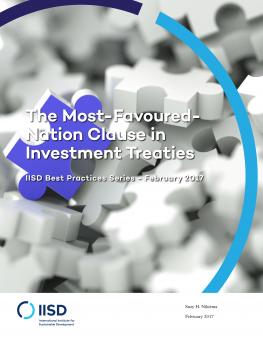
IISD Best Practices Series: The Most-Favoured-Nation Clause in Investment Treaties
This IISD Best Practices paper studies the most-favoured-nation (MFN) clause in investment treaties and its interpretation by arbitral tribunals, drawing lessons for states.
Most-favoured nation (MFN) is now a both common and controversial clause in investment treaties. It has been the object of differing and unexpected interpretations by treaty-based arbitral tribunals.
Initially, the application of MFN in investment treaties did not raise much debate. Since 2000, however, with Maffezini v. Spain, an original interpretation of MFN led to a seismic shift in international investment law: the possibility for investors protected under a bilateral investment treaty (BIT) to import more favourable provisions from a third-party BIT made by their host state. This trend then accelerated and led to many criticisms, crystallized in one essential point: the latitude given to foreign investors to bring together elements from various treaties made by the host state and to custom tailor a treaty, ignoring the bilateral character of the commitments made by two states in the context of specific negotiations.
The controversies around MFN raise fundamental questions in the context of current changes in the international investment law and arbitration regime. They require an examination of the content and scope of this clause in order to find solutions that strike a better balance of the rights and obligations involved without compromising current reforms towards a more balanced regime that is a vector of sustainable development.
After reviewing the definition and background of the MFN clause, this study conducts a typology of investment treaties and then an analysis of the differing interpretations by the tribunals of several key issues. The issues surrounding certain interpretations of the MFN clause and the reactions of states in their recent treaties are reviewed in order to draw lessons for states.
Participating experts
Additional downloads
You might also be interested in
IISD Best Practices Series: Exhaustion of Local Remedies in International Investment Law
Part of IISD’s Best Practices Series, this advisory bulletin reviews state-of-the-art options and approaches to the exhaustion of local remedies requirement in international investment law.
IISD Best Practices Series: Performance Requirements in Investment Treaties
This paper surveys the types of performance requirements (PRs) in use around the world, and briefly describes the WTO’s Agreement on Trade-Related Investment Measures (TRIMs).
IISD Best Practices Series: State-State Dispute Settlement Clause in Investment Treaties
This paper looks at state–state dispute settlement provisions in international investment agreements, examining the different mechanisms used to settle investment disputes, including judicial, quasi-judicial and arbitration procedures.
IISD Best Practices: Compensation for Expropriation
This paper analyzes the principles governing compensation for expropriation, as well as the primary methods of calculating the amount.